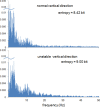Validation of smoothness evaluation during standing and sitting motions using an accelerometer
- PMID: 33814712
- PMCID: PMC8012197
- DOI: 10.1589/jpts.33.246
Validation of smoothness evaluation during standing and sitting motions using an accelerometer
Abstract
[Purpose] To quantitatively evaluate smoothness during standing and sitting motion analysis using an accelerometer and to clarify the relationship between indices. [Participants and Methods] Seventeen healthy males participated in this study. We attached a 9-axis motion sensor to the spinous process of the third lumbar spine and measured the acceleration of standing and sitting motions under normal and unstable conditions. We estimated and compared the root mean square and entropy in the lateral, vertical, longitudinal, and triaxial composite directions. [Results] On comparing both conditions, the unstable condition indices were significantly high, except for the lateral direction of entropy. The root mean square was significantly negatively correlated with entropy under normal conditions. [Conclusion] The study results suggested that the acceleration index quantitatively evaluates motion smoothness. Since each index had different characteristics, the motion-specific index was observed to be significant.
Keywords: Accelerometer; Smoothness; Standing and sitting motions.
2021©by the Society of Physical Therapy Science. Published by IPEC Inc.
Conflict of interest statement
None.
Figures
Similar articles
-
Smoothness Evaluation Indices during Sit-to-Stand-to-Sit Motions in Healthy Older Females and after Hip Fracture Using an Accelerometer: A Pilot Study.Geriatrics (Basel). 2023 Oct 1;8(5):98. doi: 10.3390/geriatrics8050098. Geriatrics (Basel). 2023. PMID: 37887971 Free PMC article.
-
Relationship between correcting error and smoothness of movement in the process of motor learning.J Phys Ther Sci. 2020 Oct;32(10):691-697. doi: 10.1589/jpts.32.691. Epub 2020 Oct 3. J Phys Ther Sci. 2020. PMID: 33132532 Free PMC article.
-
Changes in trunk sway and impairment during sitting and standing in children with cerebral palsy.Technol Health Care. 2018;26(5):761-768. doi: 10.3233/THC-181301. Technol Health Care. 2018. PMID: 29991150
-
Root mean square of lower trunk acceleration during walking in patients with unilateral total hip replacement.Gait Posture. 2017 Oct;58:19-22. doi: 10.1016/j.gaitpost.2017.07.032. Epub 2017 Jul 8. Gait Posture. 2017. PMID: 28704684
-
Does Degenerative Lumbar Spine Disease Influence Femoroacetabular Flexion in Patients Undergoing Total Hip Arthroplasty?Clin Orthop Relat Res. 2016 Aug;474(8):1788-97. doi: 10.1007/s11999-016-4787-2. Epub 2016 Mar 28. Clin Orthop Relat Res. 2016. PMID: 27020429 Free PMC article.
Cited by
-
Smoothness Evaluation Indices during Sit-to-Stand-to-Sit Motions in Healthy Older Females and after Hip Fracture Using an Accelerometer: A Pilot Study.Geriatrics (Basel). 2023 Oct 1;8(5):98. doi: 10.3390/geriatrics8050098. Geriatrics (Basel). 2023. PMID: 37887971 Free PMC article.
References
-
- Bhardwaj S, Khan AA, Muzammil M: Lower limb rehabilitation using multimodal measurement of sit-to-stand and stand-to-sit task. Disabil Rehabil Assist Technol, 2019, 10: 1–8. - PubMed
-
- Abe D, Hotta N, Fukuoka Y, et al. : Biomechanical analysis of gait and sit-to-stand patterns using a specially made knee supporter in healthy young and elderly individuals. J Physiol Anthropol, 2010, 29: 65–70. - PubMed
-
- Kojima M, Obuchi S, Mizuno K, et al. : Power spectrum entropy of acceleration time-series during movement as an indicator of smoothness of movement. J Physiol Anthropol, 2008, 27: 193–200. - PubMed
LinkOut - more resources
Full Text Sources
Other Literature Sources



